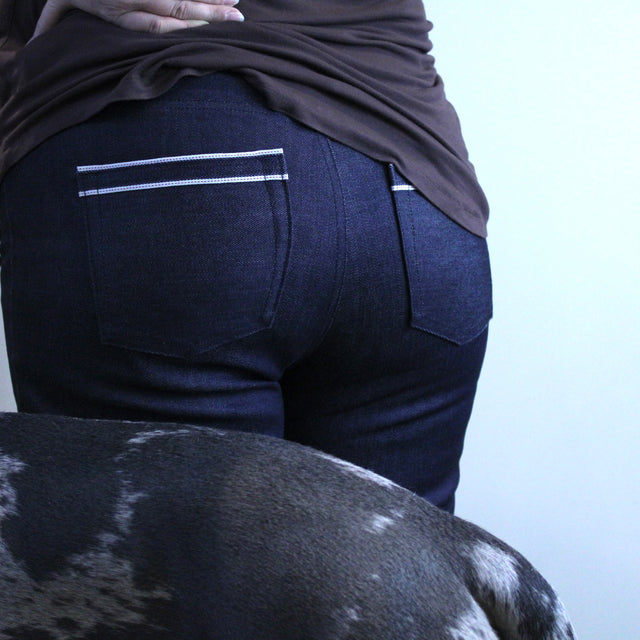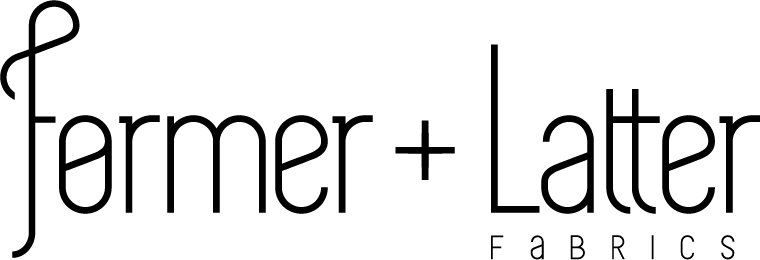
Denim For Days
With a few cathartic whacks of a hammer on the furnace room floor, I attached the button on my first pair of raw denim jeans. Side note: if you’ve read our previous blog posts, you know I am going to do my best to intentionally celebrate my creation. Also, if you are not interested in me yammering on about my affinity for denim, feel free to skip to the make details below.

This is my first memade pair of jeans, and I am really excited to see how they wear. I wanted to commit to the process of letting these beauties age, so I entered the second annual @indigoopen (#indigoopen2). It is a denim-lover’s community minded celebration of this beloved garment/textile. Essentially, I am going to wear the heck out of them for the next 9 months and minimally wash (within reason) to promote longevity and optimal fade.
I am by no means a denim connoisseur, but I have been religiously wearing jeans my whole life. They are a must in my closet. It pains me to think of a wardrobe without them. I remember getting a fresh pair of men’s Levi button-fly 501s when I was much younger than I am currently. A new pair of jeans was a splurge (with two older sisters I was the queen of hand-me-downs) and I remember wearing them until they were threadbare, then Frankenstein-ing them with patches from Dad’s old work jeans so that I could eke out as many more wears as possible. I want that for this pair.
Historically, I haven’t been interested in wearing societally typical girls' or women’s clothing. In high school, I gravitated to men’s vintage plaid dress pants, Dad’s old mohair sweaters, vintage tees and of course jeans. Believe me, I was a sight to behold. What’s interesting about this process, is that I hadn't thought about how much I truly love a good pair of jeans, until I sat down to craft a pair and share this experience with you.
I can honestly say it is one of the garments I feel most myself in.
So how’s the new pair going, you ask? Well, it's early days; I’ve only been wearing them for about a week. I must admit the first day or two, putting them on was a little reminiscent of brand new freshly donned leather boots. The Kaihara 12oz stretch selvedge is a much sturdier denim than my previous fast-fashion-jeans-wearing self is used to. I also made these to fit pretty snug at the waist, hip and thigh, so some breaking in is anticipated. The 10% stretch helps a lot; just enough to move with me, but also not bag out. After 7 wears and no washes they fit as well as they did the first time I buttoned them up.
Today when I slipped them on, I honestly thought to myself ‘I am going to love these jeans’.
I wish you all the best in your creative denim pursuits, Monique
The make details are:
Fabric: Kaihara 12oz Stretch Selvedge. This is an incredibly beautiful, structured denim with a red line selvedge. I had a lot of fun adding the selvedge detail to the jeans. I went for belt loops, waist band, back pockets, and change pocket details.

The stretch is ~10% cross grain, which is in the ‘comfort’ stretch realm. In practice this means it moves with you and has good recovery. It is appropriate for essentially any jeans, except a jegging/pull-on style which would need a higher stretch (20% cross grain).
Pattern: Closet Core Ginger. This is an awesome pattern and if you take it step by step, use the online resources at Closet Core’s website, and have a good sewing machine, this is a very achievable make for any intermediate sewist.
Because I was hoping to use this pattern again and again, I chose to trace it onto a poly sheet (used as vapour barrier – see local hardware store; we buy a roll and split it with a few people). Before tracing, I do a couple important things: try to measure the pattern (subtracting the seam allowances) and test key areas of the pattern against my body (waist, calf, thigh). I also grab a pair of jeans I currently wear and measure the pieces up against my jeans.

Once I’ve landed on a size, I trace it out, and add or subtract as needed based on my measurements/comparison. For example, on this pair I adjusted the leg shape to end up with the fit I wanted. Then I cut my pieces, and MOST IMPORTANTLY, baste the inner and outer leg seams to test and adjust fit before moving forward with the overall make. Even if you’ve used this pattern before, this is critical with each fabric since they all behave differently. In my case, once they were basted and on, I had to take the jeans in at the side seams.
Topstitching: I opted for Navy. I do love traditional golden thread, but because I was using the selvedge in quite a few places, I wanted that to be the focus.
Hardware: I went with Black; same logic as noted above, keep the selvedge the focus.

Comments (1)
The jeans look great, the fit very attractive – much better than the men’s vintage plaid pants. I am interested to see how the denim wears. I love the detail you added with the selvedge as the contrast with the dark denim really shows off the white. They will look great year round. Hope you enjoy them for a long time. P.S. So glad you are sewing and making a garment for yourself that you took pleasure in creating.